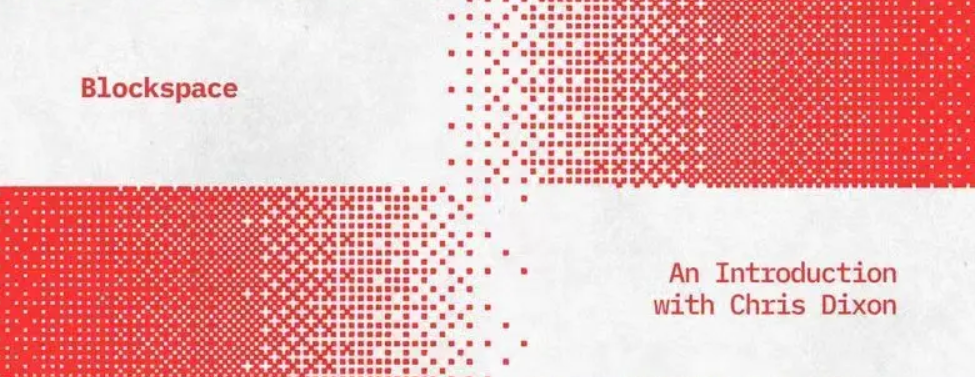對話a16z合夥人Chris Dixon:「區塊空間」是未來十年最佳產品
本文來自 The Generalist,由Odaily 譯者Katie 辜編譯。

本文來自
,由Odaily 譯者Katie 辜編譯。
本文來自
本文來自
牛市多賺錢,熊市多學習。
二級標題
就在幾個月前,a16z Crypto 合夥人Chris Dixon 稱區塊空間是本世紀20 年代的“最佳產品”。我們有幸邀請到a16z 的加密貨幣負責人進一步解釋為什麼這麼說,以及我們可以就此進行哪些佈局。
以下是投資者、運營方和創始人們應該了解的有關區塊空間的內容。
1. 區塊空間是什麼?
二級標題
區塊鏈的構建方式是不同的:利用共識機制,實現軟件“負責”硬件。
區塊鏈創業者通過編寫軟件代碼,對產品未來的行為做出強有力的承諾。
2. 這是一個有趣的表達。我以前從未見過從軟件和硬件之間關係的角度來討論這個話題,你真正討論的其實是控制問題,對嗎?
二級標題
對比比特幣。比特幣承諾只會有2100 萬個比特幣,這條規則被嵌入在比特幣區塊鏈的架構(代碼)中。即使很多運行比特幣代碼的人(礦工)試圖顛覆這些規則也很難做到(硬件控制權太分散了)。
這就是區塊空間的不同之處。構建在區塊鏈生態之上的開發人員和企業家需要知道這個規則,它們不會像傳統科技公司那樣被控制。
3. 設計區塊空間(製造公鏈)時,哪些考慮因素最重要?
二級標題
另一個重要的特性是性能。這與在區塊鏈上進行交易時支付的費用有關。製造出性能更好的系統,就能降低這些費用。有人認為要在安全方面做出權衡來獲得性能。但顯然,安全性和性能都是重中之重。另一個需要考慮的問題是圍繞區塊鏈的社區。以太坊是一個健康的開發者社區的例子。其它區塊鏈更多地關注投機和賭博,我認為它們不太健康。二級標題因此,一方面,區塊鍊是計算機,所以它們的安全性和性能很重要;另一方面,它們也是社交網絡,需要專注於構建健康的社區。
二級標題4. 最有趣、最有潛力的擴展區塊鍊及其空間的方法是什麼?
區塊鏈可擴展性是一個能引發激烈辯論的話題。一些鏈,
。如果它們的架構正確,L2 繼承了L1 的安全屬性,仍然擁有以太坊的強大安全保障。它們也在頂層提供額外的區塊空間容量,Dapp 可以以較低的gas 費用運行。現在有一些優秀的L2:Optimism、Arbitrum、zkSync、 Aztec 和Starkware。
例如,Solana 正試圖在L1 實現所有的規模化。
二級標題目前也有跨鏈橋讓鏈的互操作、來回發送資產和消息可行。
二級標題
關於哪種方式是增加區塊空間供應的最佳方式,我個人認為,以上概述的這三種主要方法可以混合使用。
二級標題“元宇宙”描述了一系列新興技術,包括Web3,VR,甚至互聯網的總體發展。
它會被一個大公司(像Meta)以一種中心化的方式控制,還是會像早期的互聯網那樣去中心化呢?
二級標題
我認為區塊空間是一種新興的、關鍵的計算資源,與帶寬、存儲、計算等傳統計算資源並列。
二級標題
在我看來,大部分區塊空間是不可替代的,這將限制其金融化。
二級標題
二級標題
正文
二級標題正文7. 你提到了拍賣方面的改進,你最近最感興趣的是什麼?還在哪些地方看到了機會?
我們一直關注核心L1 的創新。例如,我們參與了幾個從Meta 衍生出來的項目,它們有有趣的分佈式系統創新。作為提高區塊鏈性能和隱私屬性的方法,零知識證明也有不錯進展,我們正在積極投資。 L2 也有很多有趣進展。將所有的東西連接在一起的跨鏈橋也很重要。
我預計區塊鏈將遵循之前計算浪潮的共同模式:
二級標題
這就是為什麼當你在高速公路上修建另一條車道時,往往會有更多的車流量;人們在該地區建造更多的商店,吸引更多的車流量。區塊鏈也將出現類似的動態。
二級標題在未來10 到20 年裡,對更多基礎設施的創新和擴大規模的興趣和機會將是無止境的。
二級標題



